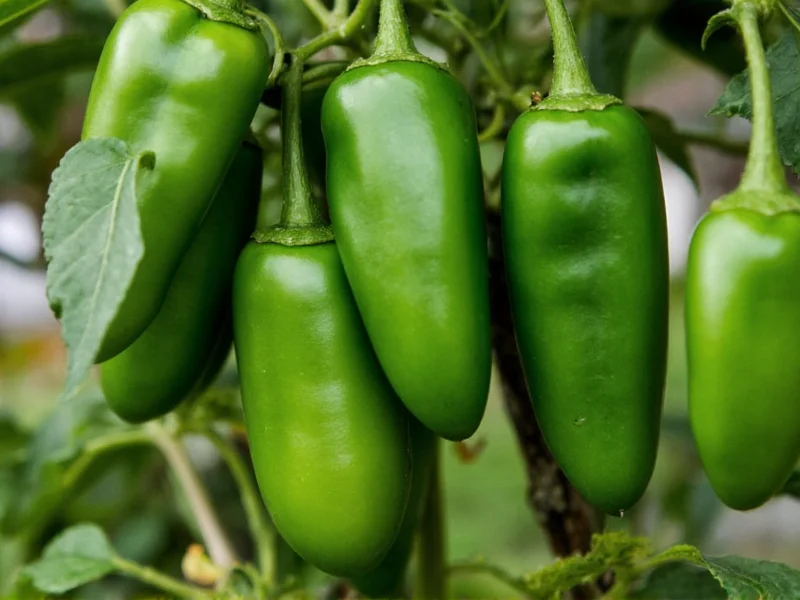Understanding pepper heat requires knowledge of the Scoville scale, the standard measurement for chili pepper pungency. Developed by pharmacist Wilbur Scoville in 1912, this scale quantifies the concentration of capsaicinoids—the compounds responsible for that burning sensation we associate with spicy foods.
What the Jalapeño Scoville Range Really Means
When we say jalapeños range from 2,500 to 8,000 SHU, this represents significant variability in actual heat experience. Several factors contribute to this wide range:
- Ripeness: Green jalapeños (less ripe) tend to be milder, while red jalapeños (fully ripe) often pack more heat
- Growing conditions: Soil composition, climate, and water stress affect capsaicin production
- Individual variation: Even within the same plant, heat levels can differ between peppers
- Seed and membrane content: The white pith and seeds contain most capsaicin
| Pepper Variety | Scoville Heat Units | Relative Heat Comparison |
|---|---|---|
| Bell Pepper | 0 SHU | No heat |
| Jalapeño | 2,500-8,000 SHU | Mild to medium |
| Serrano | 10,000-23,000 SHU | 2-3x hotter than jalapeño |
| Habanero | 100,000-350,000 SHU | 15-40x hotter than jalapeño |
| Ghost Pepper | 855,000-1,041,427 SHU | 100-400x hotter than jalapeño |
Practical Implications of Jalapeño Heat Levels
The moderate Scoville rating of jalapeños makes them incredibly versatile in culinary applications. Unlike extremely hot peppers that require careful handling, most people can consume jalapeños without significant discomfort while still experiencing that characteristic spicy kick.
Chefs and home cooks appreciate jalapeños for their balanced heat profile. The 2,500-8,000 SHU range provides enough spice to enhance dishes without overwhelming other flavors. This moderate jalapeño Scoville heat makes them ideal for:
- Adding subtle heat to salsas and guacamole
- Stuffing with cheese or other fillings
- Creating mild to medium hot sauces
- Adding flavor dimension to Mexican and Southwestern cuisine
- Preserving through pickling or canning
Factors That Influence Jalapeño Heat Perception
Several elements affect how we experience the heat of jalapeños beyond their Scoville measurement:
- Food matrix: Fatty foods like cheese or avocado can mitigate perceived heat
- Individual tolerance: Regular consumers develop higher heat tolerance over time
- Preparation method: Removing seeds and membranes significantly reduces heat
- Cooking technique: Roasting can mellow the heat while enhancing flavor
Understanding these factors helps explain why two jalapeños with identical Scoville ratings might feel differently hot when consumed. The context of consumption matters as much as the absolute heat measurement.
Common Misconceptions About Jalapeño Heat
Several myths persist about jalapeño heat levels and the Scoville scale:
- Myth: All jalapeños have the same heat level
Reality: Natural variation means significant differences even within the same batch - Myth: Smaller jalapeños are always hotter
Reality: Size correlates weakly with heat; environmental factors play larger roles - Myth: The Scoville scale measures precise heat for each pepper
Reality: It measures ranges based on laboratory testing of multiple specimens
Modern testing methods like High Performance Liquid Chromatography (HPLC) have largely replaced the original subjective Scoville Organoleptic Test, providing more accurate and consistent measurements of capsaicin concentration that translate to the Scoville Heat Units we reference today.
How does the Scoville scale for jalapeño compare to other common peppers?
Jalapeños (2,500-8,000 SHU) are significantly milder than habaneros (100,000-350,000 SHU) but hotter than poblano peppers (1,000-2,000 SHU). They're about 2-3 times milder than serrano peppers and approximately 15-40 times milder than habaneros. This moderate jalapeño Scoville heat makes them accessible to most spice enthusiasts.
Why do some jalapeños taste much hotter than others?
Variation in jalapeño heat comes from multiple factors including growing conditions (soil, climate, water stress), ripeness (red jalapeños are often hotter than green ones), and individual plant genetics. Even within the same plant, heat levels can differ between peppers due to natural biological variation in capsaicin production.
Can I reduce the heat of jalapeños while cooking?
Yes, you can significantly reduce jalapeño heat by removing the seeds and white membranes (placenta), which contain most of the capsaicin. Soaking chopped jalapeños in salt water or milk before use can also draw out some capsaicin. Cooking methods like roasting or boiling can mellow the heat while preserving flavor.
Are red jalapeños hotter than green jalapeños?
Generally, yes. Red jalapeños are fully ripe versions of green jalapeños and often develop higher capsaicin levels as they mature. However, this isn't an absolute rule as growing conditions significantly impact heat development. Some green jalapeños can be hotter than red ones depending on environmental factors during growth.
How accurate are Scoville ratings for individual jalapeños?
Scoville ratings represent ranges based on testing multiple specimens, not precise measurements for individual peppers. Modern HPLC testing provides more accurate capsaicin measurements than the original subjective taste test, but natural variation means your specific jalapeño might fall anywhere within the 2,500-8,000 SHU range, or occasionally outside it.











 浙公网安备
33010002000092号
浙公网安备
33010002000092号 浙B2-20120091-4
浙B2-20120091-4